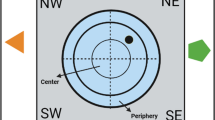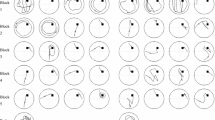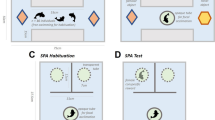Abstract
In both humans and rodents, males typically excel on a number of tasks requiring spatial ability. However, human females exhibit advantages in memory for the spatial location of objects. This study investigated whether rats would exhibit similar sex differences on a task of object location memory (OLM) and on the watermaze (WM). We predicted that females should outperform males on the OLM task and that males should outperform females on the WM. To control for possible effects of housing environment, rats were housed in either complex environments or in standard shoebox housing. Eighty Long-Evans rats (40 males and 40 females) were housed in either complex (Complex rats) or standard shoebox housing (Control rats). Results indicated that males had superior performance on the WM, whereas females outperformed males on the OLM task, regardless of housing environment. As these sex differences cannot be easily attributed to differences in cognitive style related to linguistic processing of environmental features or to selection pressures related to the hunting gathering evolutionary prehistory of humans, these data suggest that sex differences in spatial ability may be related to traits selected for by polygynous mating strategies.


Similar content being viewed by others
References
Beck K-D, Luine V-N (2002) Sex differences in behavioral and neurochemical profiles after chronic stress: role of housing conditions. Physiol Behav 75:661–673
Beiko J, Lander R, Hampson E, Boon F, Cain D-P (2004) Contribution of sex differences in the acute stress response to sex differences in water maze performance in the rat. Behav Brain Res 151:239–253
Berger-Sweeney J, Arnold A, Gabeau D, Mills J (1995) Sex differences in learning and memory in mice: effects of sequence of testing and cholinergic blockade. Behav Neurosci 109:859–873
Blokland A, Rutten K, Prickaerts J (2006) Analysis of spatial orientation strategies of male and female Wistar rats in a Morris water escape task. Behav Brain Res 171:216–224
Cain D-P, Saucier D, Hargreaves E-L, Wilson E, DeSouza J-F (1993) Polypropylene pellets as an inexpensive reusable substitute for milk in the Morris milk maze. J Neurosci Methods 49:193–197
Dab I-E, Robert M (2004) Have sex differences in spatial ability evolved from male competition for mating and female concern for survival? Cognition 91:221–257
Dix S-L, Aggleton J-P (1999) Extending the spontaneous preference test of recognition: evidence of object-location and object-context recognition. Behav Brain Res 99:191–200
Eacott M-J, Norman G (2004) Integrated memory for object, place, and context in rats: a possible model of episodic-like memory? J Neurosci 24:1948–1953
Elliott B-M, Grunberg N-E (2005) Effects of social and physical enrichment on open field activity differ in male and female Sprague-Dawley rats. Behav Brain Res 165:187–196
Ennaceur A, Michalikova S, Bradford A, Ahmed S (2005) Detailed analysis of the behavior of Lister and Wistar rats in anxiety, object recognition and object location tasks. Behav Brain Res 159:247–266
Gaulin S-J-C (1995) Does evolutionary theory predict sex differences in the brain? In: Gazzaniga M-S (ed) The cognitive neurosciences. MIT, Cambridge, MA, pp 1211–1224
Gaulin S-J-C, Hoffman H-A (1998) Evolution and development of sex differences in spatial ability. In: Betzig L, Mulder M-B, Turke P (eds) Human reproductive behavior: a Darwinian perspective. Cambridge University Press, Cambridge, UK, pp 129–152
Hall F-S, Huang S, Fong G-W, Sundstrom J-M, Pert A (2000) Differential basis of strain and rearing effects on open-field behavior in Fawn Hooded and Wistar rats. Physiol Behav 71:525–532
Held S, Baumgartner J, Kilbride A, Byrne R-W, Mendl M (2005) Foraging behaviour in domestic pigs (Sus scrofa): remembering and prioritizing food sites of different value. Anim Cogn 8:114–121
Hodgson Z-G, Healy S-D (2005) Preference for spatial cues in a non-storing songbird species. Anim Cogn 8:211–214
Iachini T, Sergi I, Ruggiero G, Gnisci A (2005) Gender differences in object location memory in a real three-dimensional environment. Brain Cogn 59:52–59
James T-W, Kimura D (1997) Sex differences in remembering the locations of objects in an array: location shifts versus location exchanges. Evol Hum Behav 18:155–163
Jones C-M, Braithwaite V-A, Healy S-D (2003) The evolution of sex differences in spatial ability. Behav Neurosci 117:403–411
Kanit L, Yilmaz O, Taskiran D, Balkan B, Furedy J-J, Pogun S (1998) Intersession interval affects performance in the Morris water maze. Int J Neurosci 96:197–204
Kavaliers M, Ossenkopp K-P, Galea L-A, Kolb B (1998) Sex differences in spatial learning and prefrontal and parietal cortical dendritic morphology in the meadow vole, Microtus pennsylvanicus. Brain Res 810:41–47
Kavaliers M, Ossenkopp K-P, Prato F-S, Innes D-G, Galea L-A, Kinsella D-M, Perrot-Sinal T-S (1996) Spatial learning in deer mice: sex differences and the effects of endogenous opioids and 60 Hz magnetic fields. J Comp Physiol [A] 179:715–724
Larsson F, Winblad B, Mohammed A-H (2002) Psychological stress and environmental adaptation in enriched versus impoverished housed rats. Pharmacol Biochem Behav 73:193–207
Leggio M-G, Mandolesi L, Federico F, Spirito F, Ricci B, Gelfo F, Petrosini L (2005) Environmental enrichment promotes improved spatial abilities and enhanced dendritic growth in the rat. Behav Brain Res 163:78–90
McBurney D-H, Gaulin S-J-C, Devineni T, Adams C (1997) Superior spatial memory of women: stronger evidence for the gathering hypothesis. Evol Hum Behav 18:165–174
Pena Y, Prunell M, Dimitsantos V, Nadal R, Escorihuela R-M (2006) Environmental enrichment effects in social investigation in rats are gender dependent. Behav Brain Res 174:181–187
Perrot-Sinal T-S, Kostenuik M-A, Ossenkopp K-P, Kavaliers M (1996) Sex differences in performance in the Morris water maze and the effects of initial nonstationary hidden platform training. Behav Neurosci 110:1309–1320
Petersen K, Sherry D-F (1996) No sex difference occurs in hippocampus, food-storing, or memory for food caches in black-capped chickadees. Behav Brain Res 79:15–22
Pham T-M, Soderstrom S, Winblad B, Mohammed A-H (1999) Effects of environmental enrichment on cognitive function and hippocampal NGF in the non-handled rats. Behav Brain Res 103:63–70
Postma A, Izendoorn R, De Haan E-H (1998) Sex differences in object location memory. Brain Cogn 36:334–345
Saucier D-M, Green S-M, Leason J, MacFadden A, Bell S, Elias L-J (2002) Are sex differences in navigation caused by sexually dimorphic strategies or by differences in the ability to use the strategies? Behav Neurosci 116:403–410
Silverman I, Eals M (1992) Sex differences in spatial abilities: evolutionary theory and data. In: Barkow JH, Cosmides L, Tooby J (eds) The adapted mind: evolutionary psychology and the generation of culture. Oxford University Press, New York, pp 533–549
Steimer T, Driscoll P (2003) Divergent stress responses and coping styles in psychogenetically selected Roman high-(RHA) and low-(RLA) avoidance rats: behavioural, neuroendocrine and developmental aspects. Stress 6:87–100
Tapp P-D, Siwak C-T, Estrada J, Holowachuk D, Milgram N-W (2003) Effects of age on measures of complex working memory span in the beagle dog (Canis familiaris) using two versions of a spatial list learning paradigm. Learn Mem 10:148–160
Teather L-A, Magnusson J-E, Chow C-M, Wurtman R-J (2002) Environmental conditions influence hippocampus-dependent behaviours and brain levels of amyloid precursor protein in rats. Eur J Neurosci 16:2405–2415
Vallortigara G (1996) Learning of colour and position cues in domestic chicks: males are better at position, females at colour. Behav Processes 36:289–296
Zhu S-W, Yee B-K, Nyffeler M, Winblad B, Feldon J, Mohammed A-H (2006) Influence of differential housing on emotional behaviour and neurotrophin levels in mice. Behav Brain Res 169:10–20
Zimmermann A, Stauffacher M, Langhans W, Wurbel H (2001) Enrichment-dependent differences in novelty exploration in rats can be explained by habituation. Behav Brain Res 121:11–20
Acknowledgements
This research was funded by a discovery grant from NSERC and the Canada Research Chairs program to DMS, and scholarships from NSERC to SRS and AJK. This research was performed in compliance with the laws of Canada regarding animal care and research.
Author information
Authors and Affiliations
Corresponding author
Rights and permissions
About this article
Cite this article
Saucier, D.M., Shultz, S.R., Keller, A.J. et al. Sex differences in object location memory and spatial navigation in Long-Evans rats. Anim Cogn 11, 129–137 (2008). https://doi.org/10.1007/s10071-007-0096-1
Received:
Revised:
Accepted:
Published:
Issue Date:
DOI: https://doi.org/10.1007/s10071-007-0096-1




